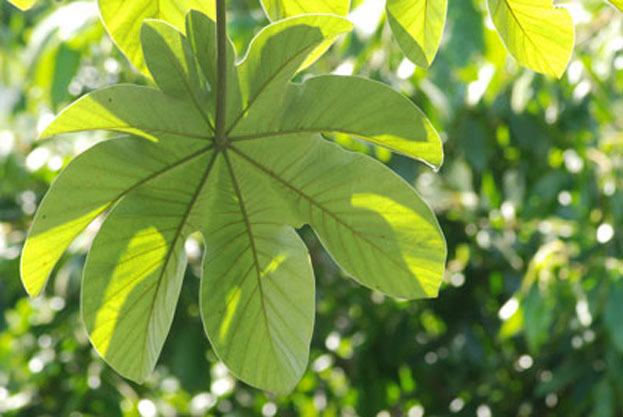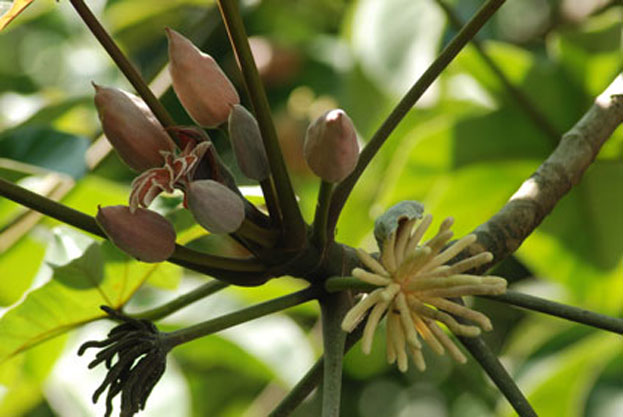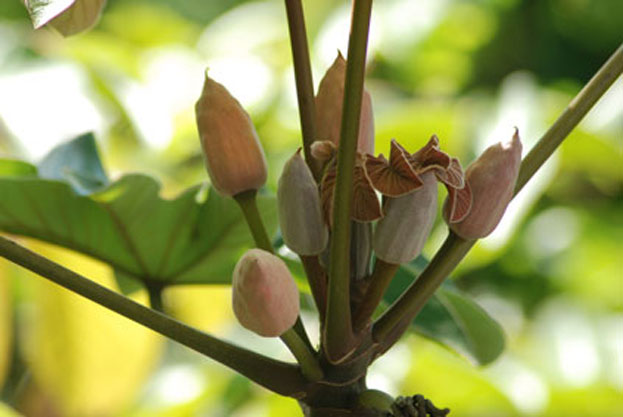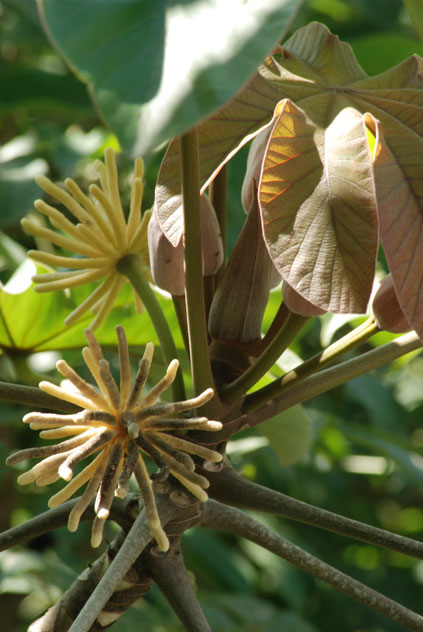Guarumo, smoked (instead of tobacco) in Alta Verapaz
Standley and Steyermark (1946:22) state that Cecropia obtusifolia is smoked in Alta Verapaz. In case you have any doubt about whether the Maya smoke, note that the name of this tree in Belize is the tobacco tree! But everyone else says it is called the trumpet tree in Belize.
The wool separated from the stems and leaves is said to be sometimes smoked by the Indians of Alta Verapaz, like tobacco. Velasquez, in notes accompanying the original specimens of Cecropia obtusifolia, remarks that it is on this tree that the bird called "ciacia" (chacha or chachalaca) builds its nests.
The local name, "guarumo," gives its name to a caserio of San Marcos, called El Guarumo. In British Honduras the tree is called "trumpet." The name "guarumo" is probably of West Indian origin. Oviedo cites it as "yaruma," which probably is closest to the original form of the word.
Ant symbiosis with guarumo tree, Cecropia obtusifolia
A symbiotic relationship is when two species evolve together and end up depending on, and helping, each other. In Guatemala there are two plants that have a symbiotic relationship with an ant host: guarumo tree is one of these two plants. The other plant is a bush, that is common in Peten and nearby areas. In the bush the ants live inside hollow thorns.
Ants of the genus Azteca inhabit the inside of the Cecropia (Longino 2006) as seen in the informative Ants of Costa Rica, www.evergreen.edu/ants/AntsofCostaRica.html
Cecropia-Azteca interaction (mutualism reward defense) the plant provides the ant colony food called Mullerian bodies, the which consist mainly of glycogen and also provides shelter for the establishment and nesting colony in the hollow trunks of the tree. Furthermore, the ants provide protection and defense against herbivores, in addition to providing the service removal of epiphytes and lianas, which compete for light and represent an extra weight for Cecropia. There is a period of the life cycle of the plant, the stage of seedling to sapling, which is not observed in the presence of ants. This is because at this stage, the seedlings do not show even the attributes that make suitable for colonization (appearance of several Trichilia assets and a hollow log). These attributes are met around 7 to 12 months of age.
Plants in this species harbor large populations of ferociously stinging ants; Cecropia peltata provides its guests with both food and lodging. It is known to flower during the rainy season, May to August.
Since guarumo is in some respects a giant weed, and as once the forest of tall trees return to the milpa, the guarumo will be shaded out. It is known to flower during the rainy season, May to August.
Ethnographic situation
The word in Yucatec Maya dictionaries is kooché.
The tree trunk can be used as a water pipe, since it is pretty much hollow.
Influorescence is edible
The leaves are eaten by cattle, and in Salvador the leaves are salted, after which cows are said to eat, them in quantity.
The infructescence is edible, with a flavor similar to that of fig. The fruits have a relatively high nutritional value, have a higher proportion of protein than other Moraceae and Lauraceae.
Inflorescence is edible
The leaves are eaten by cattle, and in Salvador the leaves are salted, after which cows are said to eat, them in quantity.
Is Guarumo a tree out of which you can make a blow-gun?
Blowguns are often seen pictured in polychrome paintings on Late Classic Maya vases, bowls, and plates, used by hunters. The Hero Twins also use blowguns, as we know from the Blom Plate (Hellmuth 1987:back cover) and from the Popol Vuh story.
Reportedly blowguns are most easily made from the guarumo, for several reasons: it is relatively straight; most of the tree is hollow anyway; and the wood is not very heavy. Plus the guarumo tree grows fast and is common in abandoned milpas.
However there is no mention of guarumo whatsoever in the 2003 article by Carol Ventura on Maya blowguns of the Jalkatec Mayan people of Highland Guatemala. So until there is evidence, from actual Mayan people, that guarumo can produce a viable blowgun, the hollow aspect of this tree may not be enough. Perhaps it was more important to have a harder wood so the inside could be polished (so less friction for the pellet as it is blown out the tube).
Guarumo and the quetzal
The quetzal bird enjoys eating wild avocado (it is smaller than domesticated avocado). And the quetzal likes to eat guarumo.
Where to find guarumo?
You can see this throughout Peten, especially in cleared areas which are beginning to regrow. Often around houses some of the guarumo trees are allowed to continue to grow. They get relatively large and aged-looking. The young upstarts are more common and typify this tree.
I do not have any guarumo in my garden, since I don’t have much space and the tree is so easy to find in Peten.
Recently we found lots of guarumo in a garden between a gas station and Centro Cultural la Galeria, in Salama.
Contact information
We thank Raul Fernandez, VicePresident, of the Asociacion that manages the Centro Cultural la Galeria, for letting us use his roof terrace so we could be at the same level as the guarumo flowers to photograph them more easily.
Address: 3rd Calle 9-83, Zona 1, Salama, Baja Verapaz, Guatemala
Telephones (502) 5407-7901, (502) 7940-1780
e-mail: This email address is being protected from spambots. You need JavaScript enabled to view it.
Bibliography
OCAMPO, Rafael and Michael J. BALICK 2009 Plants of Semillas Sagradas: an ethnomedicinal garden in Costa Rica. Finca Lunda Nueva Lodge.
www.conabio.gob.mx/conocimiento/info_especies/arboles/doctos/49-morac3m.pdf , This has zero illustrations but tells you everything botanical that you need to know about this tree. Very thorough.
First posted October 2011

















































































